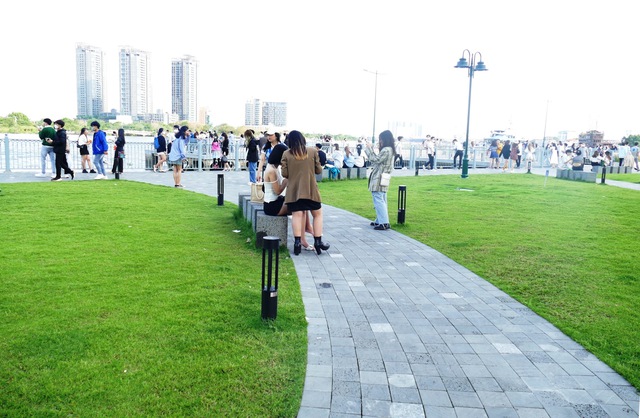
Ho Chi Minh City is always an attractive place for living and working for Vietnamese people and international investors – Photo: VGP
Position Identification
In 49 years of development (since the Liberation of Southern Vietnam and Reunification of the Country on April 30, 1975) of Ho Chi Minh City, we can divide it into different stages: Post-war economic recovery and development stage (1976 – 1985); Initial economic reform stage (1986 – 1995); Accelerated industrialization and modernization stage (1996 – 2010); Economic development in depth stage (2011 – 2020), and the City’s new economic development path (2021 onwards).
Together with the whole country, throughout each development stage, Ho Chi Minh City has always affirmed its leading position, not only in terms of economic growth, contribution to GDP and state budget, social security implementation, but more importantly, the City has become a pioneer in economic thinking innovation, exploration and breakthrough, creating new driving forces for development.
Ho Chi Minh City is one of the first localities in the country to establish a “regional linkage”. In the early years of the renovation, Ho Chi Minh City, together with Dong Nai and Ba Ria – Vung Tau, became a dynamic economic development triangle throughout the country. Then, since the end of the 1990s, Ho Chi Minh City became the center of the southeastern economic development quadrilateral and became the connecting and developing center of the entire Dynamic Economic Zone – the Southern Key Economic Zone (KTTDPN).
In the 2011 – 2020 period, Ho Chi Minh City’s GRDP increased by an average of 6.86%/year; in 2020, the City’s economic scale accounted for over 25.79% and the economic density was more than 41.49 times higher than the whole country.
The City’s economy achieved a high growth rate in the 2016 – 2019 period; however, from 2020 onwards, due to the direct impact of the COVID-19 pandemic, the City’s growth declined significantly in 2020 – Two years later, there was a quite impressive recovery but not as expected.
In the first quarter of 2024, Ho Chi Minh City’s economy continued to show positive signs. Accordingly, the GRDP is estimated to reach 6.54% compared to the same period in 2023, ranking 2nd/5 centrally-run cities and 2nd/6 localities in the Southeast region. Notably, the industrial – construction sector continued to recover, increasing by 5.66%; export turnover increased by 7.5%; tourism revenue increased by 23.8%; public investment was accelerated right from the beginning of the year, with a disbursement rate 3.4 times higher than the same period in 2023.
| Year | Ho Chi Minh City economic growth (% GRDP) | Vietnam economic growth (% GRDP) |
|---|---|---|
| 2016 | 8.05 | 6.21 |
| 2017 | 8.25 | 6.81 |
| 2018 | 8.30 | 7.08 |
| 2019 | 8.32 | 7.02 |
| 2020 | 1.39 | 2.91 |
| 2021 | – 6.78 | 2.58 |
| 2022 | 9.03 | 8.02 |
| 2023 | 5.81 | 5.05 |
Ho Chi Minh City and Vietnam’s economic growth 2016 – 2023 (Source: General Statistics Office of Vietnam)
The above results show that Ho Chi Minh City’s economy still maintains an important position, making a significant contribution to the economic growth of both the KTTDPN region and the whole country.
Specifically, the City continued to lead the country in a series of important economic indicators in 2023: GRDP accounting for 15.5% of the country’s GDP; contributing to the state budget by about 20%; attracting FDI reaching 5.85 billion USD, up 48.5% compared to the same period in 2022…
As of December 31, 2022, there are 274,067 enterprises operating in the city area, accounting for 30.6% of the total number of enterprises operating in the country. The city also leads the country in business density with 29.2 enterprises/1,000 population. In 2023, although the economy faced many difficulties, there were still 53,164 newly established businesses. This is a bright spot, proving that the City’s investment environment is constantly being improved.
In particular, the attraction of Ho Chi Minh City is also reflected in the fact that the City is always an attractive place for living and working for Vietnamese people and international investors. According to the latest report of the Center for Community Development and Support (CECODES), the Real-time Analytics Company (RTA), and the United Nations Development Program (UNDP) in Vietnam on “Provincial public administration and governance performance index in Vietnam” (PAPI), Ho Chi Minh City is the locality chosen by people from all over the country to live the most (21.68%) with reasons such as family reunion (35.4%) and better employment (35.1%) accounting for the highest proportion.
It can be said that Ho Chi Minh City has continued to maintain its advantages and become a place for gathering, starting a business, and promotion chosen by enterprises and people.

Ho Chi Minh City’s goal by 2030 is to become a center of economy, finance, trade, science – technology…
“Pioneer” position needs to be developed to a new scale
The title of “Pearl of the Far East”, or the “pioneer” economic position of Ho Chi Minh City, has been affirmed in practice; however, according to the development perspective, these titles and positions must be inherited and developed on a new scale in the new context.
In recent years, there have been quite a few concerns from managers, scientists and people about the “lag” of Ho Chi Minh City’s economy compared to other localities in the region and the country, both in terms of the proportion of contribution to GDP and the state budget of the City for the whole country has gradually decreased compared to 20, 30 years ago…
From a development perspective,












